Chess Notes
Edward Winter
When contacting us by e-mail, correspondents are asked to include their name and full postal address and, when providing information, to quote exact book and magazine sources. The word ‘chess’ needs to appear in the subject-line or in the message itself.
| First column | << previous | Archives [181] | next >> | Current column |
11430. Resigning (C.N. 6884)
C.N. 6884 reproduced this advice from page 92 of the 1 April 1949 Chess World:
‘... never resign just to show you can see your opponent’s threats.’
C.J.S. Purdy reverted to the matter on page 184 of the August 1961 issue of his magazine:
‘Never play quickly against a slow resigner just to show how easy it is. Likewise, never resign prematurely just to show you recognize your game is lost. In other words, showing off doesn’t pay.’
11431. Exact dates
Some observations by Jeremy Gaige on page 3 of his booklet A Catalog of U.S.A. Chess Personalia (Worcester, 1980):
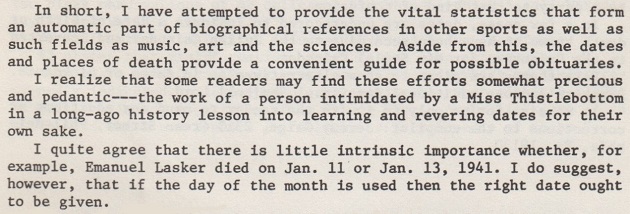
11432. Claims about Alekhine (C.N.s 11410 & 11414)
Regarding the large number of languages allegedly mastered by Alekhine, C.N. 8950 showed the following from page 171 of CHESS, May 1946:
‘Alekhine’s culture and intelligence were extraordinary. He was an exceptionally well-read man and had really fluent command of about ten different languages.’
As related in C.N. 8950, there has been confusion as to who wrote those words.
The CHESS article also appears to be the original source of two widely-quoted remarks ascribed to Alekhine: ‘I dominate them all’ (in 1940, concerning masters of his own generation) and ‘I cannot conceive that nothing should be left of me after my death’.
11433. Staunton and Harrwitz (C.N. 11319)
C.N. 11319 showed extracts from Staunton’s Illustrated London News column of 5 November 1853, page 383, concerning the Harrwitz v Löwenthal match. An addition comes from page 427 of the 19 November 1853 issue:
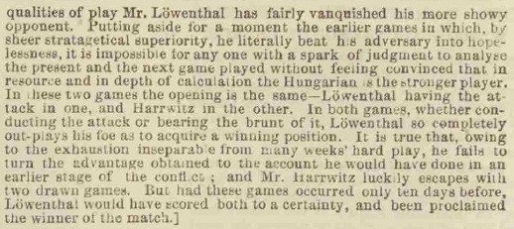
A response to both columns appeared on the cover of the December 1853 edition of Harrwitz’s British Chess Review:
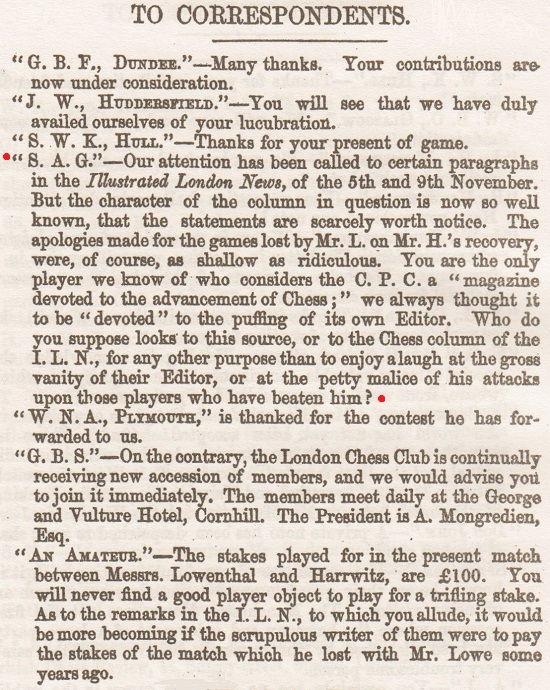
11434. Karl Hamppe
Michael Lorenz (Vienna) reports that he is currently researching the life of Hamppe, and has found that he always signed his first name ‘Karl’ (and not ‘Carl’ as generally given in chess literature).
A specimen provided by our correspondent:

11435. Non-chess books by Gerald Abrahams
From page 29 of CHESS, November 1945:

Abrahams replied on page 52 of the December 1945 issue:
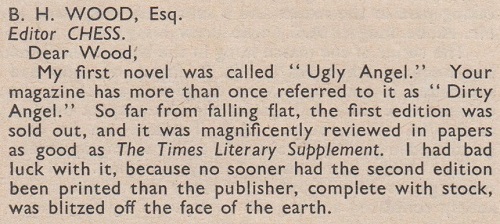
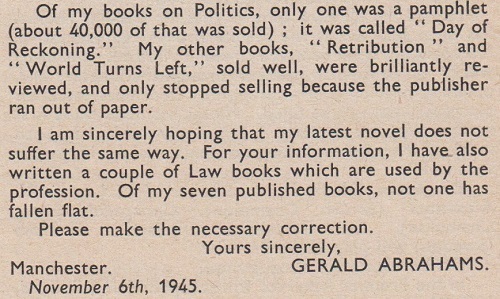
11436. Statistics
This table, one of a set forwarded by a correspondent, will be explained in the next C.N. item:
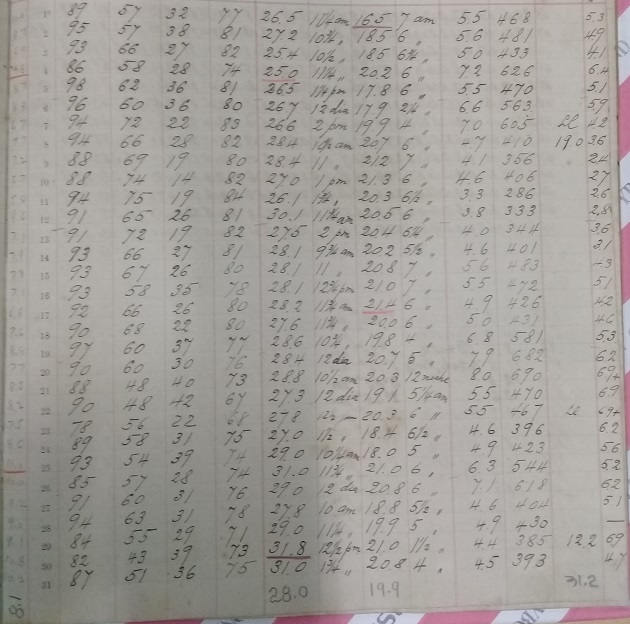
11437. The 1921 world championship match in Havana
From page 134 of The Human Side of Chess by Fred Reinfeld (New York, 1952), in the chapter on Emanuel Lasker:
‘He claimed that the climate had affected him adversely, whereas Capablanca’s praise of the climate sounded like plagiarism from a travel brochure. Who was right? Probably both men. The climate was probably unfavorable for a stranger, and an elderly man at that; and bearable to a native, who was 20 years younger.’
Lasker was aged 52 when he played the match, in March-April 1921. His remarks about the Cuban climate appeared in Mein Wettkampf mit Capablanca (Berlin and Leipzig, 1922), and two pages are shown here:
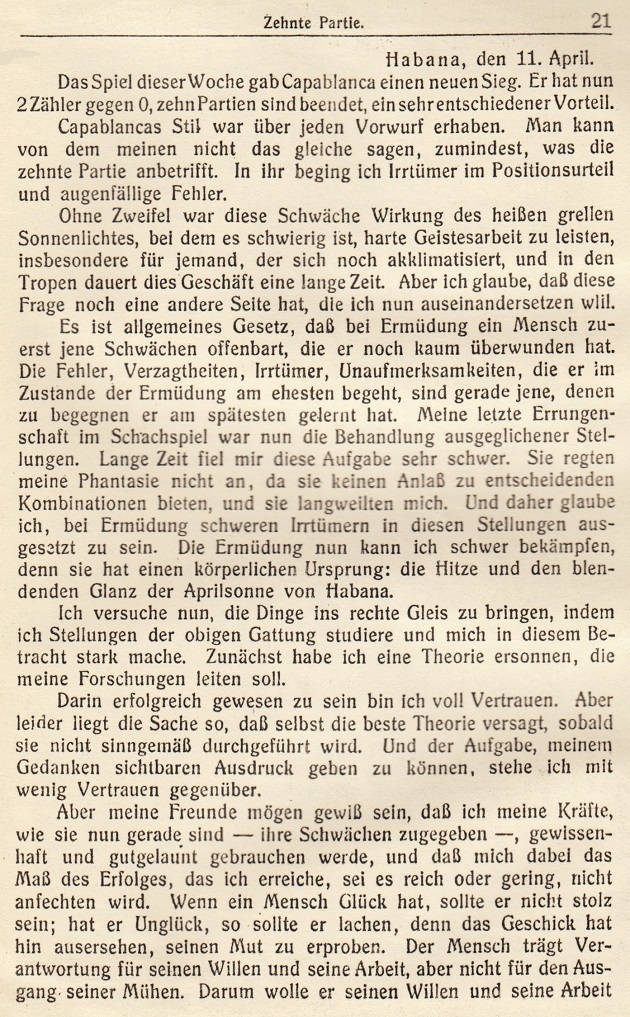
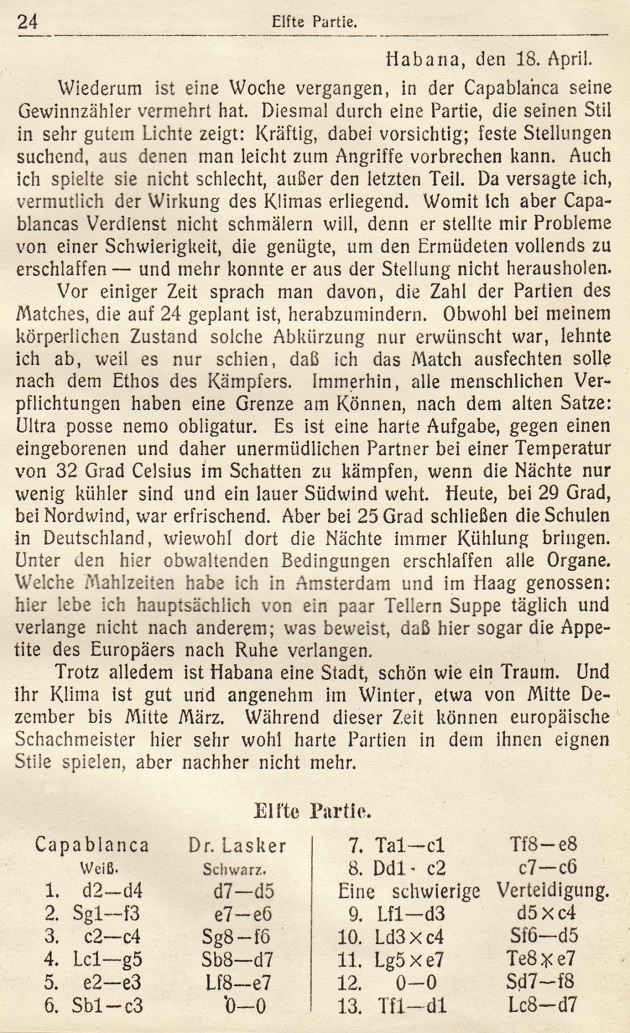
Those were the two pages specifically referred to by Capablanca in his response in 1922:
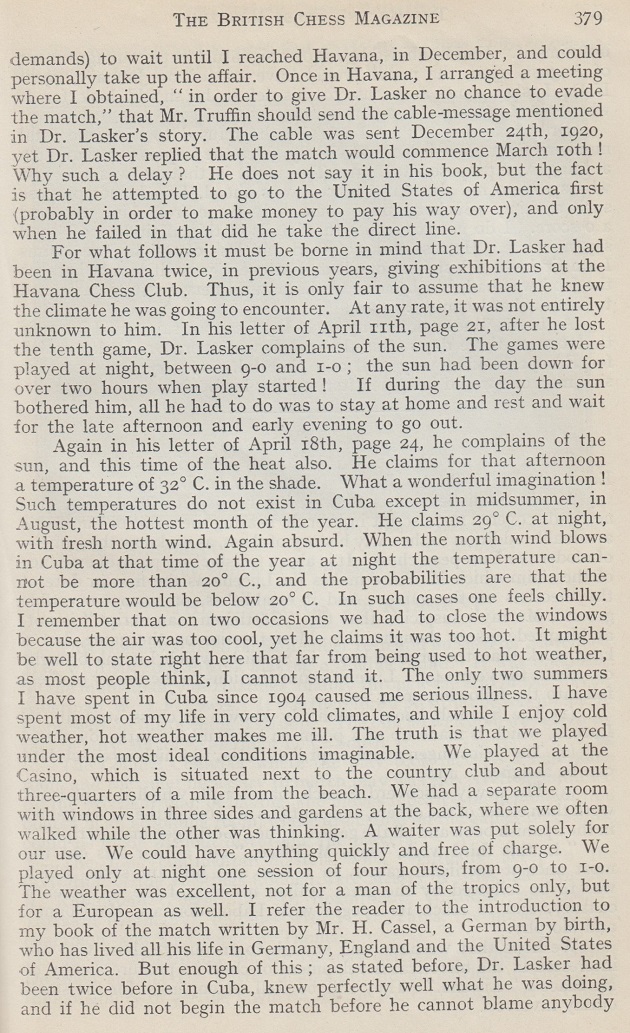
Capablanca’s Reply to Lasker has the full text, from pages 376-380 of the October 1922 BCM.
English versions of some despatches by Lasker from Havana were published in the Sunday Times in 1921 (see Lasker on the 1921 World Championship Match). He wrote a response to Capablanca’s BCM article, but the magazine refused to publish it (see page 37 of the February 1927 American Chess Bulletin).
In the archives of the Climate Center of the Institute of Meteorology in Casablanca, Havana, Yandy Rojas Barrios (Cárdenas, Cuba) has found day-by-day and hour-by-hour data on the temperature, relative humidity and winds in the Cuban capital in March and April 1921. For example:

The set of eight tables has been added to the above-mentioned feature article Capablanca’s Reply to Lasker.
11438. L. Kieseritzky
Page 219 of the Chess Player’s Chronicle, 1853 described Lionel Kieseritzky as ‘a blindfold player perhaps never surpassed’.
11439. Berlin, 1897
From the first volume (1898-99) of Alapin’s periodical Der Schachfreund (frontispiece):
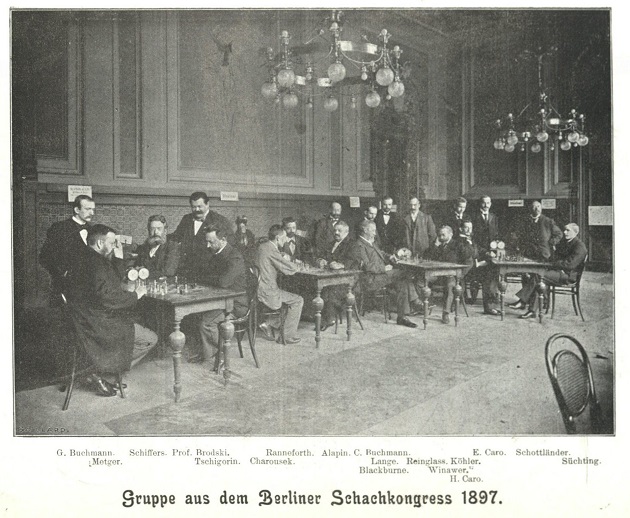
The high-resolution scan is shown here courtesy of the Cleveland Public Library, which has also authorized us to reproduce this photograph from its archives:
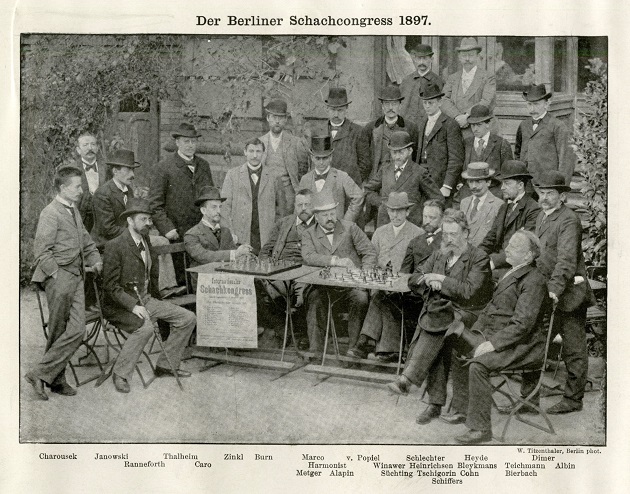
11440. Euwe in Cuba, 1947
Wijnand Engelkes (Zeist, the Netherlands) notes an article by Max Euwe on pages 664-665 of the 12/1947 issue of the Dutch magazine Op den uitkijk and, in particular, the former world champion’s comments on chess administration in Cuba on the latter page:

In summary, Euwe referred to the tensions between the two chess organizations in Cuba. The unofficial one, which bore Capablanca’s name, had become smaller but owned premises donated by the Cuban Government. Euwe felt obliged to decline an invitation to go there, as he was in Cuba as the guest of the official organization. He also strove to allay his hosts’ fears that the Cuban Government might take offence at his refusal to visit a building which it had given. Furthermore, Euwe observed that the official chess body was not anti-Capablanca, whereas the other organization tended to exaggerate (being ‘more Capablanca than Capablanca himself’).
11441. The Nimzo-Indian Defence (C.N.s 7677 & 11156)
A footnote on page 447 of The Game of Chess by Edward Lasker (New York, 1972) with regard to the term ‘Nimzo-Indian’:
‘A horrible abbreviation of Nimzovich-Indian. The mutilation of the name of the greatest chess theorist, the father of what the jocular master Tartakower called “hypermodern chess”, is as unnecessary as it is undignified.’
The note is absent from page 352 of the 1997 algebraic edition by John Nunn and Graham Burgess (Chess: The Complete Self-Tutor). Elsewhere on that page is ‘Bogo-Indian’ (not used by Lasker).
11442. Notes by Steinitz
From page 4b of the St Louis Daily Globe-Democrat, 27 March 1910:

1 d4 d5 2 c4 e6 3 Nc3 Bb4 4 Nf3 dxc4 5 Qa4+ Nc6 6 Bd2 Qd7 7 O-O-O Nf6 8 e3 O-O 9 Bxc4 a6 10 Qc2 a5 11 e4 Nxd4 12 Qd3 Rd8 13 Nxd4 Qxd4 14 Qg3 Qxc4 15 Bh6 Rxd1+ 16 Rxd1 Ne8 17 Rd8 Qf1+ 18 Kc2 Qd3+ 19 Kxd3 Resigns.
11443. Kings of the Chessboard

Kings of the Chessboard by Paul van der Sterren (Landegem, 2019), a superficial 260-page paperback, is sourceless throughout. Page 55, for instance, has a ‘once’ comment attributed to Capablanca:
‘Typically, he once commented on a game where the opening had not gone to his liking by writing “I don’t know where I went wrong, for I have the fortunate habit to forget not just games by other players, but even my own games”.’
Page 64 also purports to quote Capablanca:
‘I am invincible and I know it.’
In the chapter on the 1834 Labourdonnais v McDonnell encounters, page 14 mixes up the chess master with his great-grandfather Bertrand-François Mahé de Labourdonnais (1699-1753):

And from page 21:
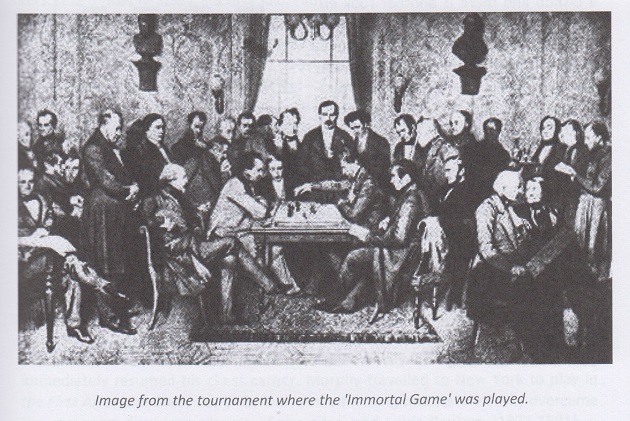
11444. Grandmasters
Among the points made on page 3 of The Guinness Book of Chess Grandmasters by William Hartston (Enfield, 1996):
- ‘The term “Grandmaster”, spelt as two words or one, sometimes with a capital G, sometimes lower case, was appropriated by the chess world from its older uses among courtiers, military orders of knights and freemasons. When it was first applied to a great chessplayer is unclear, though it certainly long pre-dates the first instance recorded in the Oxford English Dictionary in 1927.’
- ‘Regulations are a great leveller. From the five Grandmasters with a capital G, at St Petersburg, 1914 [earlier on the page Hartston referred to the ‘popular myth’ of the involvement of Tsar Nicholas II], we now have over 400 grandmasters, many of whom, if truth be told, deserve little more than a small one.
This book is about the real Grandmasters.’
The on-line entry in the Oxford English Dictionary currently stands as follows:
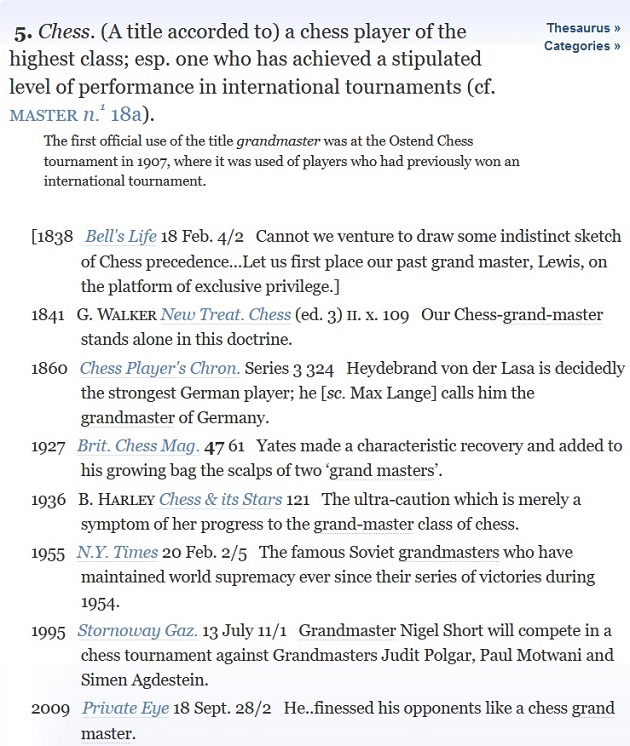
From page 61 of the February 1927 BCM:

This was in the conclusion of the report on Hastings, 1926-27, where Yates defeated Tartakower and Réti.
Our feature article on this topic is Chess Grandmasters.
11445. Photographs of Capablanca
Eduardo Bauzá Mercére (New York, NY, USA) provides the following photograph from Argentina’s Archivo General de la Nación, courtesy of the Ministerio del Interior, Obras Públicas y Vivienda (reference AR_AGN_DDF/Consulta_INV: 259951):
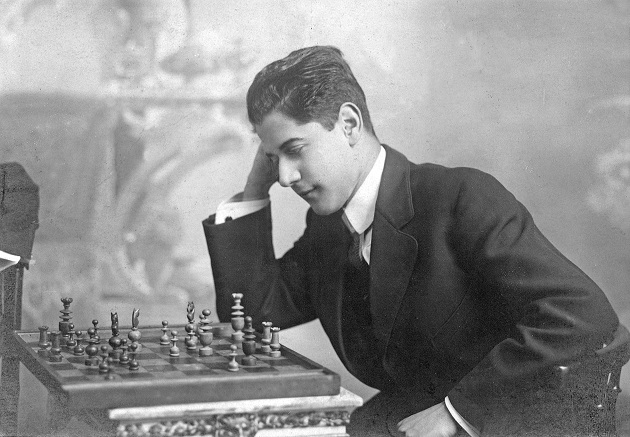
The reverse side states ‘Caras y Caretas - 25 Abr 1911 - Archivo’. This is a fine version of the portrait given in C.N.s 5235 and 9596. For a different shot of Capablanca at the same board and also showing his game against Bernstein, San Sebastián, 1911, see C.N.s 7582 and 7587.
Inventory item 260062 in the Archivo General de la Nación:
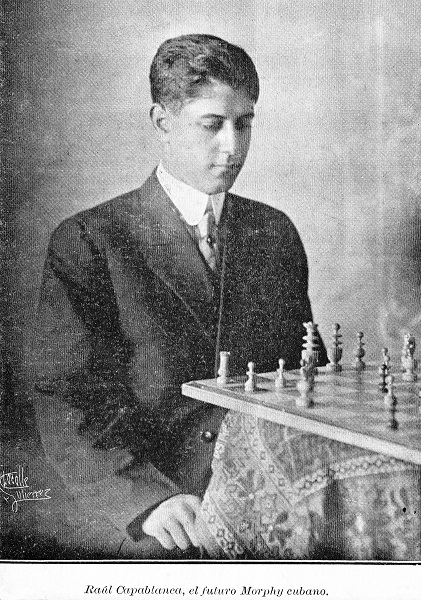
Mr Bauzá Mercére comments:
‘The reverse merely has “José Raúl Capablanca – Atento a una jugada de ajedrez”, and the stamp states “Caras y Caretas – 25 Jul 1925 – Archivo”. The board position is from the 12th game of the Capablanca v Marshall match, 13 May 1909, after 7 d3 or 7...Be7. The signature “Lacalle Gutiérrez” (bottom left) may give a clue.’
Thirdly, inventory item 260060 in the Archivo General de la Nación:
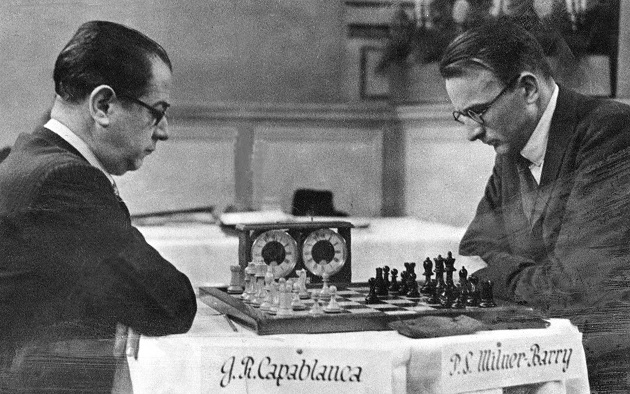
This is a fine version of a photograph in Chess Pictures in The Sphere. For another shot of Capablanca which shows the same game (Margate, 1936), see C.N.s 6204 and 6199.
11446. William Joyce (1906-46)
From page 66 of The Complete Chess Addict by Mike Fox and Richard James (London, 1987):

The same text was given, also without any source, on page 87 of the revised 1993 edition.
A news item on page 96 of CHESS, February 1946:

A number of British newspapers published on the day when Joyce was hanged for treason included the words ‘without the least sign of strain’ with reference to his chess games against prison officers. For instance:
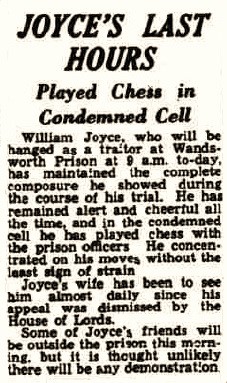
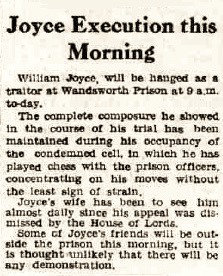
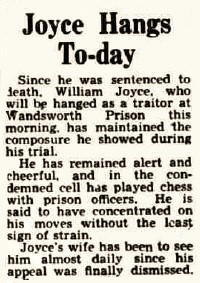
Reports in late editions the same day also mentioned chess. Two similar examples:

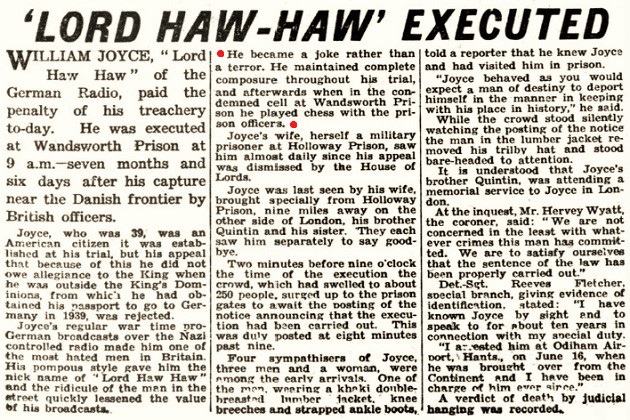
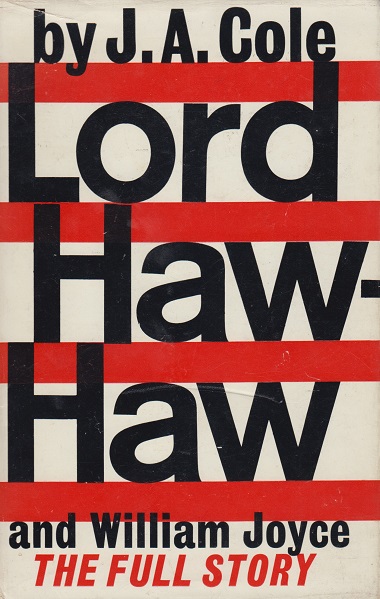
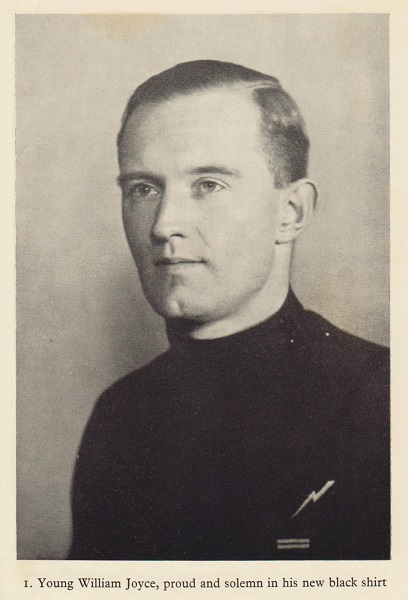
Plate opposite page 40
Page 274 of Lord Haw-Haw – and William Joyce by J.A. Cole (London, 1964) quoted a letter from Joyce to his wife regarding Wandsworth Prison (‘we have much chess’), but the most detailed reference to the game is on pages 55-56, concerning the 1930s. Joyce’s closest friend was John Angus Macnab, whose recollections included the following:

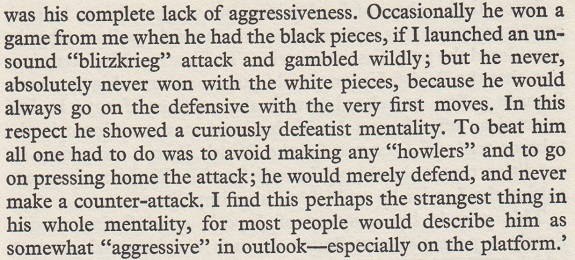
11447. Capablanca and Marshall

Regarding this photograph of Capablanca given in C.N. 11445, Lonnie Kwartler (Chester, NY, USA) notes that the board may look wrongly positioned:

However, as pointed out by Rudy Bloemhard (Apeldoorn, the Netherlands), it appears to be a case of the a-file being blocked from view by the rim of the board.
On the subject of possible misunderstandings in photographs of board positions, C.N. 5514 showed this picture from page 26 of the February 1931 American Chess Bulletin:
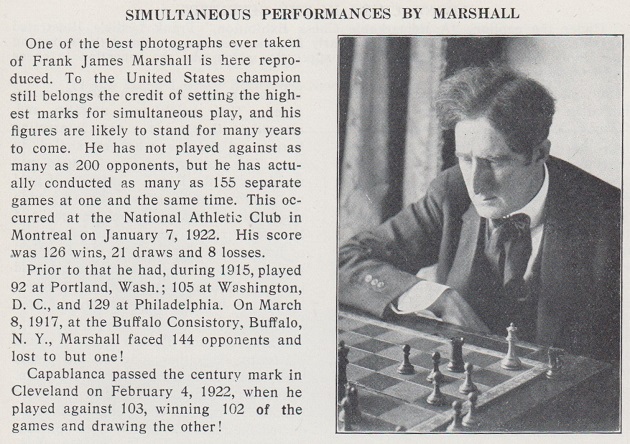
In C.N. 5124 a correspondent, Ola Winfridsson, suggested that nothing was necessarily amiss:
‘It all depends on the original shade of the squares of the chessboard; in some old black and white photographs and films, lighter colours appear darker than darker colours.’
11448. The Giuoco Piano
Roger Gabrielson (La Jolla, CA, USA) draws attention to pages 108-109 of The Giuoco Piano by E. Gufeld and O. Stetsko (London, 1996) and the following annotation after 1 e4 e5 2 Nf3 Nc6 3 d4 exd4 4 Bc4 Bc5 5 c3 Nf6 6 e5:
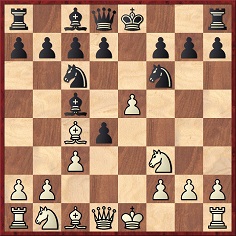
‘6...d5
Counterplay in the centre in the spirit of the Two Knights’ Defence. There is a definite risk linked with retreating [sic] the knight, which the renowned Austrian [sic] theoretician Bilguer showed in his analysis:
a) 6...Ng4 7 Bxf7+ Kxf7 8 Ng5+ Kg8 9 Qxg4 Nxe5 10 Qe4 Qe7 11 O-O h6 12 cxd4 Bxd4 13 Qxd4 hxg5 14 Nc3 with an advantage to White ...’
Our correspondent asks whether von Bilguer really gave that line, which disregards a forced mate with 9 Qb3+. The answer is no. Page 116 of the Handbuch des Schachspiels (Berlin, 1843) had 8...Ke8, and not 8...Kg8:
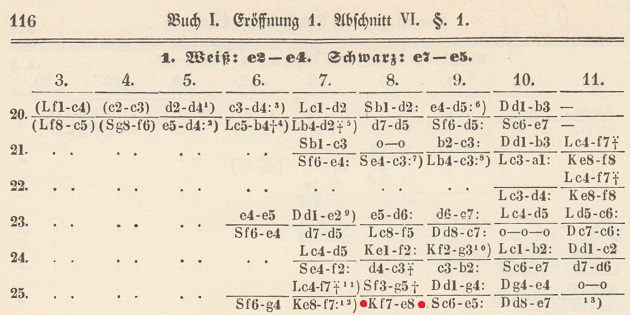
The same line is on pages 348-349 of the 1922 edition of the Handbuch, continued with 11...h6 12 cxd4 Bxd4 13 Qxd4 hxg5 14 Nc3 and the comment ‘Weiß hat zwar einen Bauern weniger, aber eine sehr starke Stellung’.
11449. Pointed out
From page 40 of the 12/2003 issue of Schach, in a lengthy examination by Robert Hübner of the first book in Kasparov’s Predecessors series:

This concerns the final game of the 1910 world title match. For an English translation see C.N. 3180 in The Lasker v Schlechter Controversy (1910). In short, replying to the claim in the Kasparov book that 50...Qb2+ was ‘another mistake that was not pointed out by anyone!’, Hübner wrote:
‘Yet it is not so astonishing that nobody has pointed out this continuation, for a queen move from c1 to b6 was against the rules of the game at the time.’
The temerarious words ‘not pointed out by anyone’ also occur on page 284 of the Predecessors volume, in connection with this position in the ‘Immortal Zugzwang Game’ (Sämisch v Nimzowitsch, Copenhagen, 1923):

Position before 24...Bd3
The assertion in Kasparov’s book:
‘Black is playing for zugzwang, but it is amusing (and also not pointed out by anyone) that it was also possible simply to win the queen: 24...Re2! 25 Qb3 Ba4 26 Rc8+ Rf8.’
The possibility of trapping the queen with 24...Re2 had already been pointed out by John Emms on page 115 of a book which he co-authored with Graham Burgess and John Nunn, The World’s Greatest Chess Games (London, 1998). The note regarding 24...Bd3:
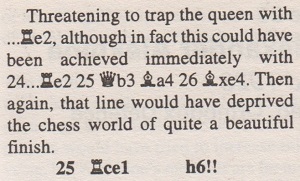
Readers may well be able to point out other precedents.
11450. Leonard Barden
Our latest feature article marks the 90th birthday of Leonard Barden.
11451. Ming Ming
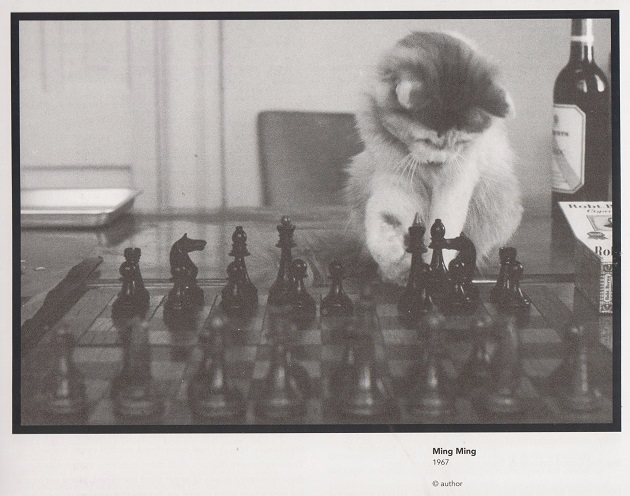
Patrick Myricest (Dublin) draws attention to the above photograph on page 129 of a book published by Reuters, Frontlines: Snapshots of History (Harlow, 2001). The chapter (pages 128-134) is by Anthony Grey, who became Reuters’ correspondent in the Chinese capital in 1967. In mid-July that year he was placed under house arrest by the foreign ministry, and until his telephone line was disconnected ...
‘... I’d played chess by telephone with John Weston, a friend in the British mission who later became ambassador to the United Nations. Then Ming Ming had often sat endearingly beside the board, dabbing delicately at the pieces with her paw, and I had photographed her doing this.’
On the night of 18 August 1967 ‘a horde of 200 Red Guards stormed my house ... yelling “Hang Grey! Hang Grey!” But instead of hanging me, the mob hanged, before my face, a fluffy brown-and-white female cat named Ming Ming which had been sharing my imprisonment with me.’
The chapter provides graphic detail, and here we merely give two pull-out quotes on page 131:
‘The Maoists had decided that pets were symptomatic of a bourgeois lifestyle ...’
‘... the violent death of Ming Ming remains a poignant symbol of the political hysteria and madness that then gripped the world’s most populous nation.’
We are grateful to Mr Anthony Grey for permission to reproduce his photograph here.
11452. Speeches (C.N. 9230)

“Among These Mates” by Chielamangus (Sydney, 1939), page 58
On pages 387-388 of Chess Secrets I Learned from the Masters (New York, 1951) Edward Lasker referred to his attendance in 1947 at the inauguration of the Capablanca Chess Club in Havana and the speech by the Cuban President, Ramón Grau San Martín:
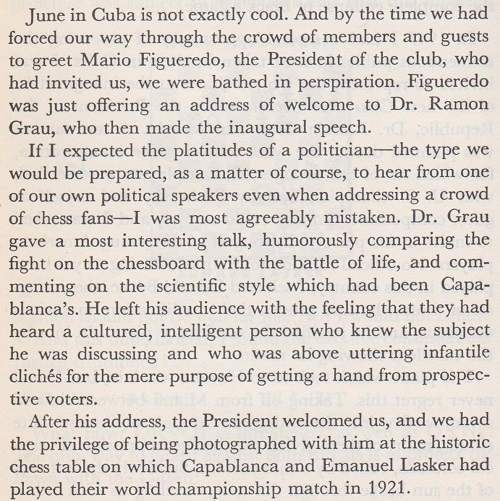
We seek a detailed report on the President’s speech.
11453. Simultaneous display by Marshall (C.N. 11447)
Russell Miller (Vancouver, WA, USA) points out with respect to the report on page 26 of the February 1931 American Chess Bulletin that F.J. Marshall’s 92-board simultaneous display was in Portland, Oregon, and not in Washington State.
For further information on the exhibition, including a photograph, see C.N. 9228. Finding game-scores remains difficult.
11454. The Ruy López (C.N.s 9298 & 9305)
C.J.S. Purdy on pages 184 and 185 of Chess World, 1 August 1949:
‘Have you noticed that the López tends to win long games and lose short ones? There’s a reason. In the López White sacrifices development for long-term theoretical advantages. Sometimes Black’s advantage in development tells quickly.’
‘Boiling water is the most efficient for washing dishes but it will scald you if you’re not very careful. The López is like that. White has certain theoretical assets which he has purchased at the cost of development. He must try not to give Black a chance to capitalize his gain in development with a sharp attack – unless, as in the Marshall, he gets a pawn or something, with a good chance of holding it.’
After a reference to Capablanca v Marshall, New York, 1918, Purdy’s article (page 184) had a comment which is quoted on page 328 of our book on the Cuban:
‘Capablanca was the gambit-killer of all time.’
11455. Bognor Regis, 1955
Page 319 of
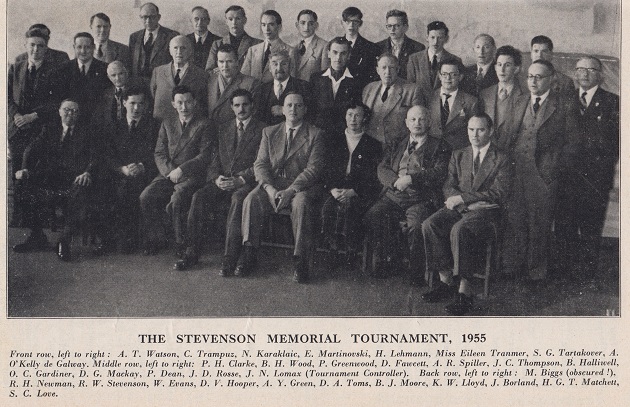
11456. Kasparov’s Predecessors books
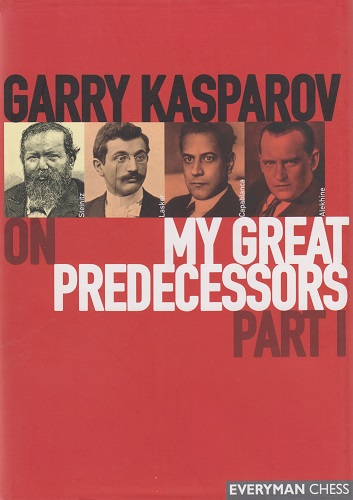
In C.N. 5375 we made this comment about pages 184-185 of the Heinemann edition of Kasparov’s book How Life Imitates Chess (London, 2007):
... he accepts that he was justifiably criticized for volume one in his Predecessors series, thereby gratifyingly pulling the rug from under those unqualified commentators who pronounced it a masterpiece. (It somehow even received the British Chess Federation’s ‘book of the year award’ in 2003.)
For the benefit of those who have excessively praised (and/or copied from) the Predecessors books, below are some of Kasparov’s remarks on pages 184-185 of How Life Imitates Chess:
‘... I began work on my series of chess books in the late 1990s. A combination of editorial haste and our confidence that our analysis was better than any that had come before led to our publishing the first volume of My Great Predecessors without enough regard for the attention the book would receive in the chess community, and what that attention signified.
The first volume appeared in the summer of 2003. My in-depth look at the first four world champions and their closest rivals quickly got its own in-depth examination from tens of thousands of chess players around the globe. Nowadays this also means tens of thousands of powerful chess computers going deeply into every move, every line of my analysis. The internet allowed this distributed network of analysts and ad hoc book critics to collect and present a remarkable, and humbling, number of corrections.
... At my insistence we began to collect and do our own analysis of the corrections so that they could be incorporated into later editions of the book. In fact, many changes were ready in time for translations of the book into other languages, so, for example, the Portuguese version, which came out a year later, is far more accurate than the first Russian edition. At the same time we made our analysis and fact-checking processes much more rigorous for the subsequent volumes and each one has been better than the last in this regard. Part V, on Karpov and Korchnoi, was published in early 2006 and I’m proud to say that the vast audience of eager would-be critics has been gratifyingly quiet!
This improvement in quality would never have happened without a willingness to accept criticism and the will to do something about it. I took it as a challenge, not as an insult.’
We are not aware of any amended editions of the English-language books, and, in particular, of the most unfortunate volume one.
11457. Prince Gedroiz/Gedroits (C.N.s 10196, 10201, 11336 & 11358)
Three further pages have been received from Yuri Kireev and Mikhail Sokolov (Moscow):
- Peterburgskaya Gazeta, 12 December 1913, page 4. Caricature featuring Capablanca (see the earlier C.N. items):

- Peterburgsky Listok, 28 April 1914, page 2. A sketch of Blackburne’s 26-board display in St Petersburg on 26 April/9 May 1914. The caption gives the score as +17 –3 =6 and names the victors, but it does not specify Gedroiz’s result. There was no report on this exhibition in Shakhmatny Vestnik. Page 178 of Deutsches Wochenschach, 17 May 1914 and page 187 of the June 1914 Deutsche Schachzeitung gave the score as +17 –2 =7.
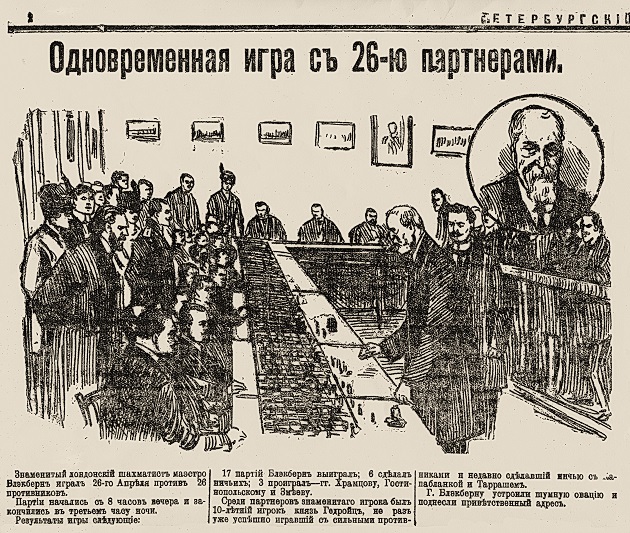
- Shakhmatny Vestnik, 1 June 1914, page 180. A report on an exhibition by Tarrasch in St Petersburg on 1 April/14 April 1914 (+20 –3 =4). Gedroiz drew.
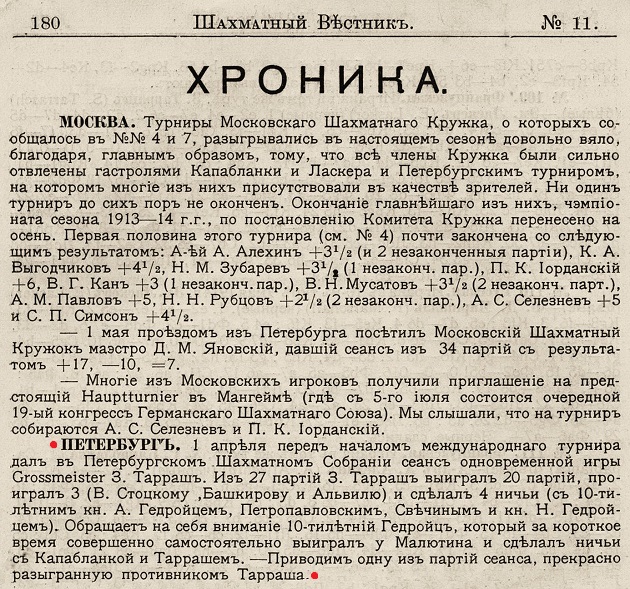
11458. Pal Benko (1928-2019)

The recent death of Pal Benko prompts us to recall the exceptional quality of Pal Benko My Life, Games and Compositions by P. Benko and J. Silman (Los Angeles, 2003). Anyone dipping into it again may care to begin with Silman’s interview with Benko on pages 425-432. It includes this comment on page 426:
‘When I gave my place to Fischer for the Interzonal in Palma de Mallorca in 1970, I was sure Bobby would advance to the Candidates Matches and beat the Russians. My own career was nearing its end, so why shouldn’t I give Fischer a chance to embrace his fate? I never had any doubts about his success, and he didn’t disappoint me.’
In ‘chess literature’ there are many vague claims that Benko was paid to cede his place in the Interzonal tournament (Palma de Mallorca, November-December 1970).
An early reference to money is at the end of an article by Miro Radojčić on pages 368-370 of the July 1970 Chess Life & Review:


Benko gave the following account on page 439 of the July 1975 issue of the same magazine:
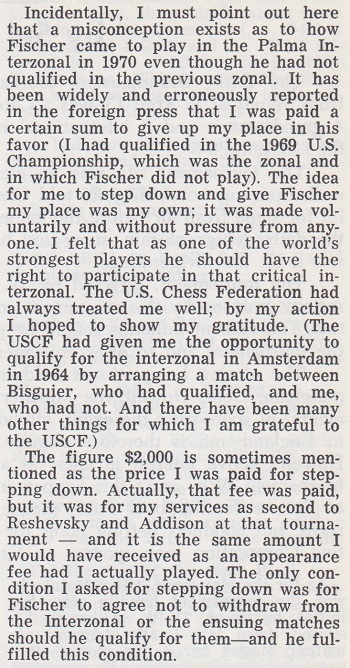
In the ‘Ask the Masters’ column on page 56 of Chess Life, July 1981 Benko reverted to the topic with a brief summary:
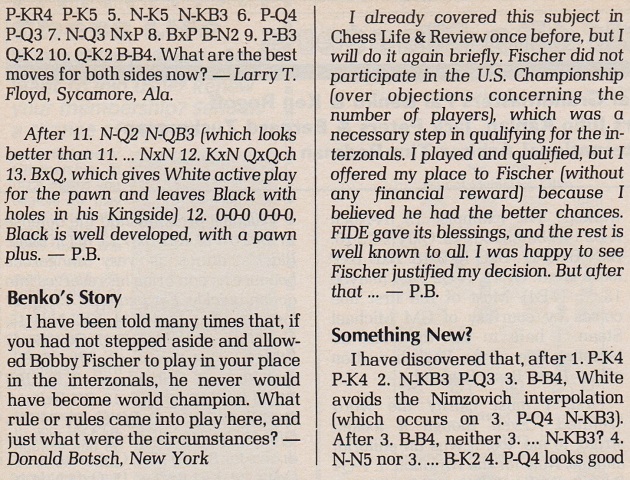
11459. Grünfeld’s grave (C.N. 5733)
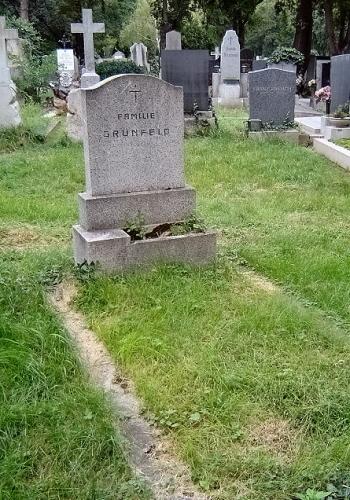
The above photograph of the grave of Ernst Grünfeld at Vienna’s Zentralfriedhof was taken by Michael Lorenz (Vienna) and shown in C.N. 5733. See too Graves of Chess Masters.
Our correspondent reports that, 11 years on, he has just revisited the grave, which is held privately (group 65, row 17, number 65):
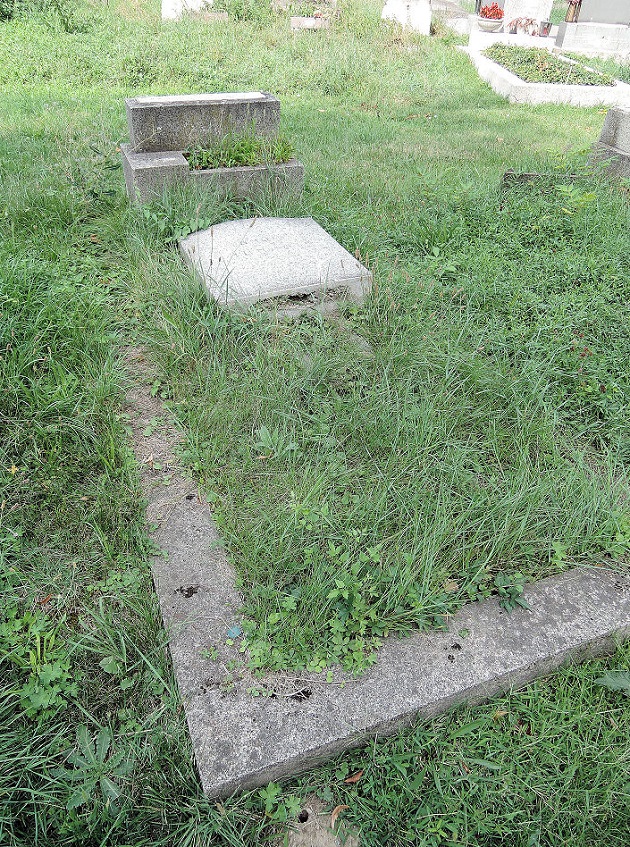
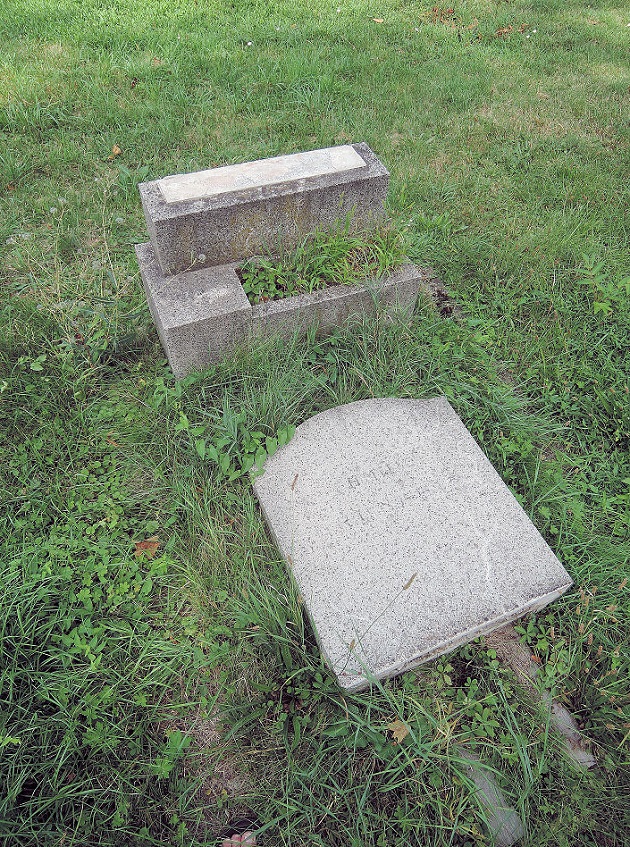
We hope to be able to report soon that the authorities have carried out the necessary restoration and preservation work.
11460. Pillsbury v Conen
From page 388 of the American Chess Magazine, March 1899:
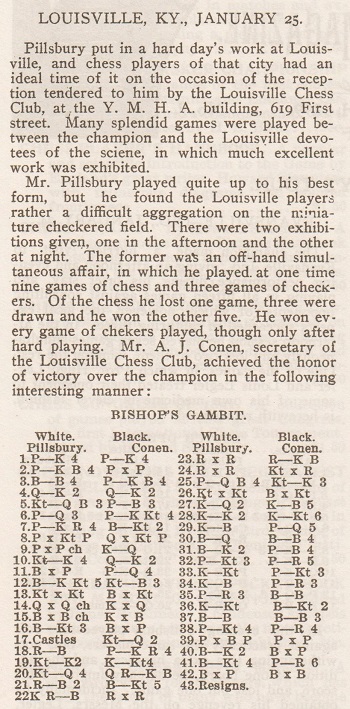
The game is by no means unknown and can be found, for instance, on page 299 of Harry Nelson Pillsbury American Chess Champion by J.N. Pope (Ann Arbor, 1996).
It is worth also noting its appearance on page 70 of the May-June 1939 American Chess Bulletin:
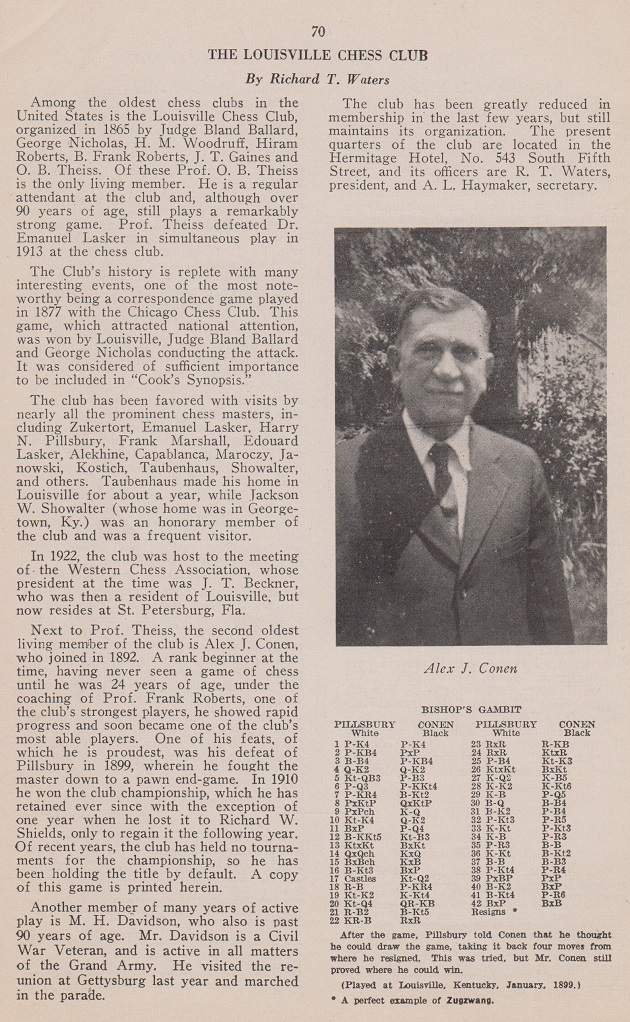
1 e4 e5 2 f4 exf4 3 Bc4 f5 4 Qe2 Qe7 5 Nc3 c6 6 d3 g5 7 h4 Bg7 8 hxg5 Qxg5 9 exf5+ Kd8 10 Ne4 Qe7 11 Bxf4 d5 12 Bg5 Nf6 13 Nxf6 Bxf6 14 Qxe7+ Kxe7 15 Bxf6+ Kxf6 16 Bb3 Bxf5 17 O-O-O Nd7 18 Rf1 h5 19 Ne2 Kg5 20 Nd4 Raf8 21 Rf2 Bg4 22 Rhf1 Rxf2 23 Rxf2 Rf8 24 Rxf8 Nxf8 25 c4 Ne6 26 Nxe6+ Bxe6 27 Kd2 Kf4 28 Ke2 Kg3 29 Kf1 d4 30 Bd1 Bf5 31 Be2
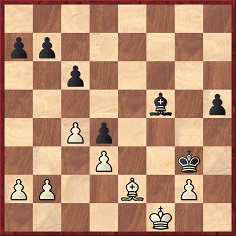
31...c5 32 b3 h4 33 Kg1 b6 34 Kf1 a6 35 a3 Bc8 36 Kg1 Bb7 37 Bf1 Bc6 38 b4 a5 39 bxc5 bxc5 40 Be2 Bxg2 41 Bg4 h3 42 Bxh3 Bxh3 43 White resigns.
11461. Schlechter photograph
Rainer Smeykal (Munich, Germany) reports that his copy of Karl Schlechter by R. Spielmann (Stockholm, 1924) has a postcard inscribed by a member of Schlechter’s family the year after he died:
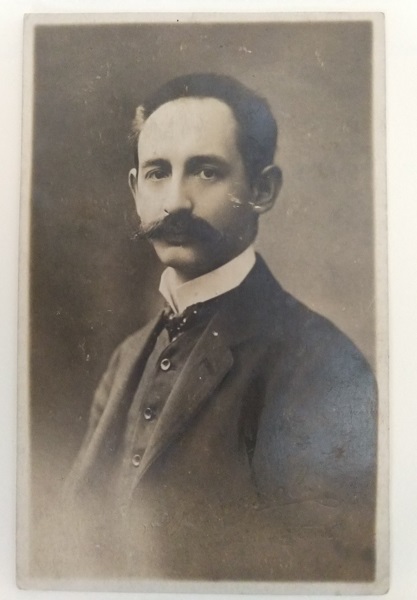
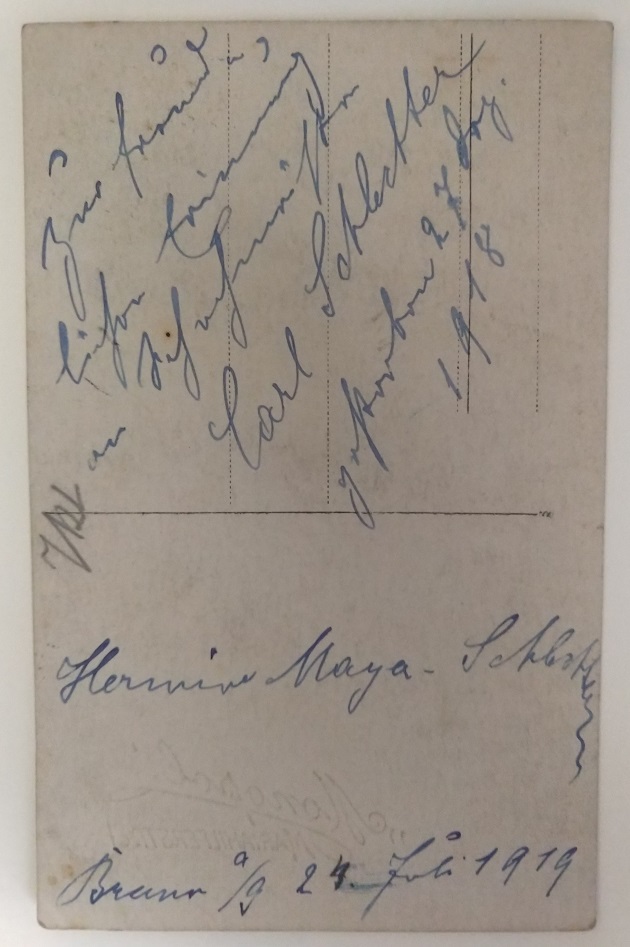
‘Zur freundlichen Erinnerung an Schachmeister Carl Schlechter gestorben 27 Dez. 1918.
Hermine Mayer-Schlechter
Brunn [am Gebirge] 24. Juli 1919.’
Mr Smeykal notes that the photograph and a similar caption (translated into English) are on page 50 of Warren Goldman’s monograph on Schlechter. On the basis of information on pages 13-15 of that book, our correspondent takes Hermine Mayer-Schlechter to be the master’s aunt.
11462. Shinkman composition
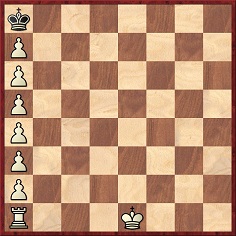
Mate in eight
Pete Tamburro (Morristown, NJ, USA) writes:
‘The solution to this problem by W. Shinkman, Globe Democrat, 1887 runs 1 O-O-O Kxa7 2 Rd8 Kxa6 3 Rd7 Kxa5 4 Rd6 Kxa4 5 Rd5 Kxa3 6 Rd4 Kxa2 7 Rd3 Ka1 8 Ra3 mate. However, there is a more “coarse” dual solution: 1 Kd2 Kxa7 2 Re1 Kb8 3 Re8+ Kc7 4 a7 Kd7 5 a8(Q) Kd6 6 Qd8+ Kc5 7 Re6 Kc4 8 Rc6 mate (with other variations). I find it hard to believe that Shinkman missed the dual, which is easily corrected by having a white pawn on e2 and a black pawn on e3, or that over a century of composers and solvers did not write something about it. Is the diagram found in several places (e.g. the BCM, September 1989, page 412) a misprint? Was it incorrectly published? Was it later corrected?’
The composition was discussed by Tim Krabbé on page 481 of the September 1977 Chess Life & Review and on page 22 of his book Chess Curiosities (London, 1985). In each case, mention was made of 1 Kd2, a move which Krabbé believed was first pointed out by Lafora and Zarski on page 96 of the March 1929 Wiener Schachzeitung:
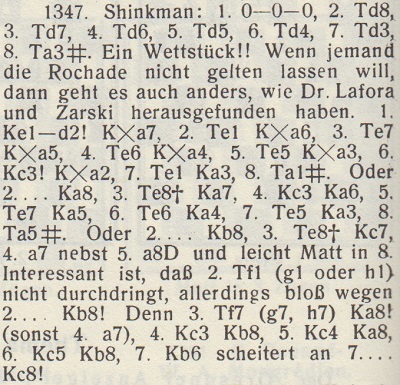
See too Krabbé’s article The Kuwait Immortal.
Below is the first appearance of Shinkman’s problem, on page 12 of the St Louis Daily Globe-Democrat, 21 May 1887:
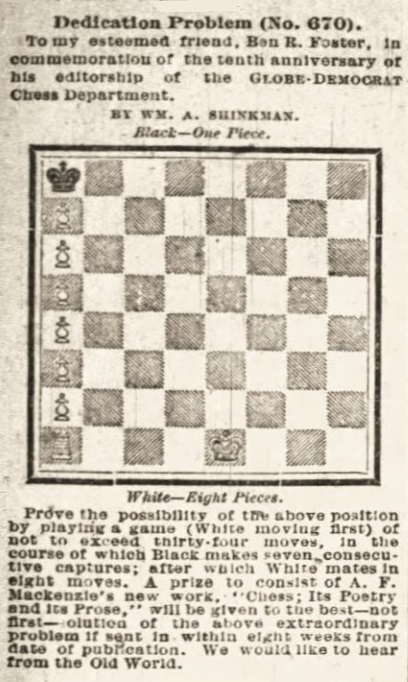
The follow-up item (solutions by Shinkman and by C.E. Lascelles) appeared on page 11 of the 3 September 1887 edition:

1 g4 h5 2 Nf3 hxg4 3 Nd4 Rh3 4 Na3 Na6 5 Nc4 Ra3 6 h4 g3 7 h5 g2 8 h6 g1(Q) 9 h7 Qg3 10 h8Q Qb3 11 Qh4 g5 12 Rh3 f5 13 Qf4 e5 14 Re3 d5 15 Bg2 Bd7 16 Be4 Ba4 17 bxa3 Bb4
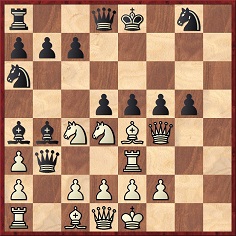
18 Bb2 c5 19 Bc3 b5 20 cxb3 exd4 21 bxa4 dxc3 22 dxc3 gxf4 23 cxb4 fxe4 24 Qd3 fxe3 25 fxe3 exd3 26 exd3 dxc4 27 dxc4 Qb6 28 cxb5 O-O-O 29 bxa6 Rd4 30 exd4 Ne7 31 dxc5 Nc6 32 cxb6 Na5 33 bxa5 Kb8 34 bxa7+ Ka8.
1 Na3 e5 2 Nc4 Ba3 3 bxa3 c5 4 h4 h5 5 g4 hxg4 6 Nh3 g3 7 Nf4 g2 8 Rh3 g1(R) 9 Re3 b5 10 Bb2 Ba6 11 Bc3 Nc6 12 Bd4 Qb6 13 Qc1 O-O-O 14 Qb1 Rg3 15 Qb2 d5 16 Qb3 f5 17 Qd3 g5
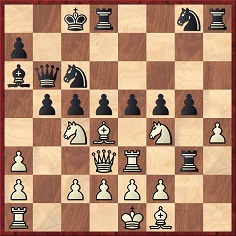
18 Bg2 Nf6 19 Bf3 gxf4 20 Be4 fxe3 21 fxe3 exd4 22 exd4 fxe4 23 dxc5 exd3 24 exd3 dxc4 25 dxc4 Rxh4 26 cxb5 Nd5 27 cxb6 Nc3 28 bxa6 Rd5 29 dxc3 Nb4 30 cxb4 Ra5 31 bxa5 Rb3 32 cxb3 Ra4 33 bxa4 Kb8 34 bxa7+ Ka8.
| First column | << previous | Archives [181] | next >> | Current column |
Copyright: Edward Winter. All rights reserved.